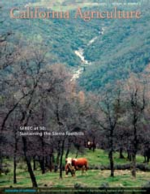Where's the beef?
By assigning a simple, 15-digit identification number to cows, UC researchers can track each one from conception to carcass, garnering valuable data for studies on cattle fertility, genetics, and health, and helping to select breeding animals with desirable beef characteristics such as flavor and tenderness.
In today’s beef market, an individual cow may change ownership many times during its lifetime as it travels from the ranch of its birth, to stocker and feedlot, to slaughterhouse, and finally supermarket or steakhouse. In the process, valuable data is lost along with the ability to “trace back” particular steaks to the original cow.
For several years, UC Davis researchers have been attaching a round, electronic ear tag to each newborn calf in the research herd at the UC Sierra Foothill Research and Extension Center, in the California foothills northeast of Sacramento.
The ear tags contain each cow’s unique radio-frequency-identification number, which is scanned with an electronic wand; the system is similar to that used to keep track of packages being shipped overnight or library books. Cowhands use a handheld device to enter information when the cattle are processed, which is transmitted via remote-access antennae to centrally located computer databases.
The integrated data-collection system is being used to undertake sophisticated studies on cattle genetics, with the ultimate goal of improving cattle breeding. “The genotype of some beef and dairy cattle may be better suited to grass-based productions systems,” UC Davis Cooperative Extension Specialist Alison Van Eenennaam and colleagues write in the April-June 2010 issue of California Agriculture journal. “It may also be possible to select animals that are able to grow to given size using less feed, or that are more resistant to certain diseases.
“These technologies also have great potential to enable the production of safer, more nutritious animal products. They may also allow for the selection of animals with a decreased environmental footprint and improved animal welfare due to lower levels of disease.”

Herd manager Dan Myers enters cattle
information into hand-held device.

